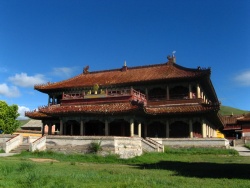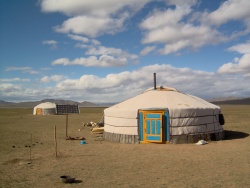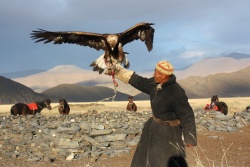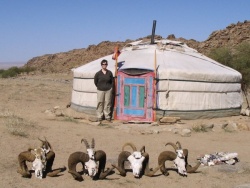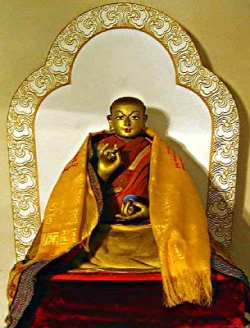Mongols and Oirats as Peacekeepers:Buddhist Warriors Behind the Lotus Throne by Richard Taupier
Editor’s introduction: Dr. Taupier’s contribution makes a provocative and well-researched assertion: that the historical role of Mongolians in enabling, promoting and ensuring the integrity and influence of Tibet – including the development of Tibetan Buddhism – is greatly under appreciated. Citing several key historical periods and examples, Mongolia’s central role is effectively documented in ways that recast our historical understanding of Mongolian importance. As Dr. Taupier suggests, the great attention given to the persona and legacy of Chinggis Khan both inside and outside Mongolia belie the key significance of other Mongolian leaders and periods.At larger issue, as discussed at length during our original conference, are the ways that Mongolians are now poised to rediscover, reinterpret, and reassert the richness of their history following seven decades of Soviet propaganda and Socialist re-writing of the Mongolian past. Given the sensitivity of much archival material, including from the socialist period, significant parts of the historical record are just now beginning to be more accessible within Mongolia to scholars as well as citizens.Future years may well see important new interpretations and assertions concerning Mongolian history, including especially by Mongolians themselves.
Histories are always written from particular vantage points. Indeed, it is not possible to speak about history except from the perspective of a specific time and orientation. Historical perspectives are colored by many influences that include ideology, ethnicity, nationality, language, methodology and knowledge of specific primary and secondary sources. We never entirely escape these limitations. We can mitigate them in part through awareness and transparency about those factors that influence our historical perspective. We can seek to understand the perspectives of other historians by knowing about the influences to which they were subject and the vantage points from which they wrote and the audiences for whom they wrote. While historical facts may be perceived as neutral, history is always a matter of interpretation.
From a global perspective, the history of Mongolia and Mongolian people is relatively unknown and under appreciated. That history unfolded within the context of nomadic culture,and is often difficult for those without an understanding of nomadism to comprehend. Much of the history of Mongolians available in English has been shaped by external cultural views that are non-nomadicand non-Mongolian – and which contributed to misunderstanding and misinterpretation. The more these perspectives are repeated and strongly held, the harder they are to correct. It is my opinion that Mongolian history and culture should be seen and studied in the same light as all the great classical cultures of the world, no different than the history of Greece, Persia, Rome, Russia, China or Tibet.
This short paper takes note of another type of historical bias, namely the way in which other more dominant historical narratives have pushed Mongolians off center stage and caused them to be seen as only minor actors during many historic eras. I have challenged myself as a historian to place Mongolians and Oirats back at center stage and try to interpret important historical periods and events from their perspective.It is only through a multiplicity of perspectives that we can begin to fashion a more holistic understanding of Mongolian contributions to world history.
Qing history is one of those dominant historical narratives by which Mongolian history is overshadowed. For Manchu rulers that was intentional. They worked diligently to assimilate the eastern Mongol uluses into the Manchu Empire and, to a large extent, describe themselves as the inheritors of earlier Mongolian legacies. Their perspective was one in which all other narratives were sub-themes within the history of the Great Qing. Qing historiography is I think well understood in this respect.
Tibetan historical narratives have also unintentionally marginalized Mongolian history, but in other ways. First is the volume of historical materials from which Tibetan historians can draw; these are far greater than the materials available to historians of Mongolia. Tibetan histories, written from Tibetan perspectives, view other players as temporary agents. Tibet also occupied a centrally important ideological position in Buddhist Central Asia, with other cultures viewed as the recipients of those ideological values. It is the key reason that the Qing Dynasty worked so hard to place Tibet in a subservient role, to deny it independent moral authority from which other [[Wikipedia:Central Asian|Central Asian]] rivals might draw support and legitimacy.
But of greater importance to the current lack of parity among Chinese, Tibetan and Mongolian historical perspective is what has happened over the past fifty to sixty years. Tibet, in its ongoing struggle to re-gain its independence, has done well in capturing global attention. Tibetan and Chinese historians have promoted competing narratives intended to influence public opinion about whether Tibetans have a legitimate historical claim to independent status. Our own positions in that dialogue are not central to this presentation. Neither of these perspectives is my concern in this paper, though their influence is important to note.
What is central to this paper is the construction and promotion of historical narratives about the roles that Mongolians have played in the affairs of Central Asia and the world during the past 800 years. In addressing this issue, it is important to move beyond the Chinggisid period and the Yuan Dynasty to discuss the ways in which later Mongols and Oirats altered the course of Asian history – and of world history – and gave us the legacies that allow us to understand how the robustly modern nation of Mongolia has been built on the outcomes of many past events. In doing so we can encourage others to gain a better appreciation for the ways in which Mongolians and other steppe cultures have contributed to the world as we now know it.
We can begin by looking back on some of the most important contributions that Mongolians have made relative to Tibet. We should note that Tibet itself was once the heart of a great [[Wikipedia:Central Asian|Central Asian]] Empire. While that Empire had fallen apart more than 300 years before the rise of Chinggis Khan,its cultural influences were still strongly felt throughout much of Central Asia, especially through the agency of its religious orders and great lamas. But Tibet itself was often torn by regional and sectarian rivalries and violence. Aristocratic clans rose to regional prominence following the dissolution of imperial authority in the late 9th century. By the 11th century aristocratic clans began to patronize and become associated with competing Buddhist and Bon lineages. This was a period in which Tibetan Buddhism experienced an important second wave of development, as the Nyngma lineage experienced resurgence and the Kagyu, Sakya and Kadampa schools all began to take shape under the influence of early spiritual leaders and secular patrons.
But after its early imperial period, Tibet was able to experience periods of centralized authority and national unity only under the direct influence of external agents. From the 13th through the 17th centuries, Mongols and Oirats were the external influences that brought peace and stability to Tibet and allowed the Tibetans to realize many of their greatest accomplishments. The first time the Mongols played a direct role in Tibetan affairs was during the time of Godan Khan, the second son of Ogedei.
Godan Khan lived in the Kokonor region but all of Tibet was considered within his domain. In 1240 he demanded that the great Sakya Pandita should appear at his court and instruct him and his nobles in Buddhist Religion. In return,some sources indicate that Sakya Pandita was given authority over the thirteen fiefdoms of central Tibet. The Sakya leader instructed Tibetans that resistance to Mongol authority would be disastrous and that in return for tribute and help in matters of religion the Mongols would help the Tibetans to spread their religion far and wide. This version of events seems now to be rather simplified and truncated but the reality is that soon there after Mongol control and centralization of authority in Tibet was complete.
Sakya Pandita died in 1251 and Godan Khan in 1253.But Khubilai Khan, who inherited Godan’s realm, quickly established a similar relationship with Sakya Pandita’s heir and nephew, Sakya Phakpa. The rapport between Phakpa Lama and Khubilai Khan is well known. By 1264 Phakpa Lama had been given religious and temporal control not only of central Tibet but also of Amdo, Khams and Western Tibet. Sakya control of Tibet continued after the death of Phakpa Lama in1280 but began to decline not long after the death of Khubilaiin 1295. Without strong central authority internal strife again arose in Tibet. All of the thirteen central Tibetan myriarchies(districts “controlled by ten thousand rulers”) be came embroiled in a conflict that ended in the year 1350 when the Pakmodrupa gained eminence and were soon recognized by the Mongol Yuan Emperor Toghun Temur as the central authority in Tibet. With the end of the Yuan Dynasty in 1368,Mongol influence in Tibet ended.
The next most significant period of Mongol influence came in the late 16th century and in a quite different manner.By the early 15th century Je Rinpoche Tsongkhapa had established the Gandenpa tradition, which would later become known as the Gelukpa lineage. Gendun Drubpa, later known as the First Dalai Lama, a direct disciple of Tsongkhapa, was instrumental in establishing its early institutions. The Second Dalai Lama, the first recognized Gelukpa tulku, continued that building tradition. By the time of the Third Dalai Lama the Gelukpas were attracting many followers and patrons. Asa consequence they began also to develop enemies and rivals who feared their success and coveted the resources flowing toward them. Thus, when Altan Khan of the Tumed Mongols requested Sonam Gyatso to come to Kokonor in 1576 to spread the Dharma and encourage the so-called second wave of expansion to the Mongols, Sonam Gyatso and his followers were happy to be out of harm’s way, under the protection of powerful Mongol leaders.
Thus Mongol patronage and protection, while not directly influencing Tibetan affairs, firmly established and protected the religious institution of the Dalai Lamas, created the Dalai Lama as a [[Wikipedia:Central Asian|Central Asian]] and not merely a Tibetan spiritual leader, and led to a great influx of wealth to Gelukpa institutions. It is not a stretch to say that without Mongolian patronage the early Gelukpa movement might well have withered and died before reaching maturity.
The Third Dalai Lama also created the great monastery at Kum Bum in Kokonor. Sonam Gyatso and his followers extended Gelukpa influence into Central Mongolia when the Abatai Khan took refuge and brought his people under the influence of the Dharma. It was a stroke of karmic genius when the Fourth Dalai Lama was born to a grandson of Altan Khan, a just reward for Mongolian patronage. No other non-Tibetan people, with the possible exception of the Khoshuds and the Kalmyks, share such a strong karmic relationship with the Dalai Lamas. To this day he is commonly regarded as one of their own. When the Fourth Dalai Lama was escorted to Lhasa by a strong contingent of Mongol cavalry, the Mongols signaled yet again that he and the religious institutions of which he was the leader continued to enjoy powerful protection.
Following the early passing of the Fourth Dalai Lama in 1617 the Manchus succeeded in driving a wedge between Mongolia and Tibet. Nor were the Mongols a unified people. The Chakhar Mongols rose as enemies of the Gelukpas and the young Fifth Dalai Lama. When a Chakhar army was sent to Tibet in 1637 it was the Oirats under the leadership of Gushii Khan who rose to the defense. It was they who became the next great patrons and protectors of the Dalai Lamas. Gushii Khan led the majority of the Khoshud people into the Kokonor region where many have remained until this day. He not only protected the Dalai Lamas from a hostile Mongol minority,but also took on and fnally defeated all of the internal enemies of the Dalai Lama in Tibet.
As a consequence Gushii Khan was recognized as the defacto King of Tibet and was indeed given that title by the young Fifth Dalai Lama. But in 1642 Gushii Khan, following in the footsteps of Godan and Khubilai Khan, gave to the Great Fifth Dalai Lama the ultimate offering, complete authority over the political and religious affairs of Tibet. The result was the reintroduction of central political control and the enabling of an extended period of growth and stability perceived now as Tibet’s golden age. It was only in the 18th century that Khoshud power waned in Tibet and Manchu power rose. But it is entirely appropriate to credit the Mongols with establishing the Dalai Lamas as pivotal, universal spiritual leaders in Central Asia and the Oirats with credit for establishing the Dalai Lamas as the political leaders of Tibet and creating the form of Tibetan government that exists to this day, unfortunately in exile.
Tibet is now recognized as one of the great classical cultures of Central Asia and indeed the world. Yet few people in the world know or appreciate to what extent those accomplishments were made possible only with the support of various Mongol peoples over many centuries. This is what I intend when I say that it is important to balance historical accounts and to give appropriate credit to the many important Mongolian contributions of the past thousand years, not just at the time of Chinggis Khan, but up to the present. This is only one of many potential historical accounts that often remain untold. Additional well-researched historical narratives about Mongolian contributions to world history are needed to balance global knowledge of Central Asia.
I would like to end with one other short effort in re-examining important periods in Mongolian history. I have found it quite puzzling that Mongolians have looked almost exclusively to Chinggis Khan as their historic role model and cultural hero. Some three years ago I asked a Mongolian friend and scholar why Mongolians seem reluctant to recognize more recent historic figures as key role models in Mongolian history and whom might be considered to have played important roles in the making of modern Mongolia. I was quite surprised when he answered “Galdan Boshugtu, because it was he who forced the Khalkha Mongols to seek the protection of the Qing Empire.” I asked, why not Zannabazar? He replied“many people blamed him for surrendering to the Manchus and forfeiting Mongolian freedom.” Indeed Manchu rule hurt Mongolia’s development badly and left scars still visible today.
But let us reflect on that. What if Zannabazar had not made that choice? What if he had joined with the Zunghar effort, opposed the Manchus, and lost, only to see Mongolia fully assimilated into the Qing Empire in the same way as Kokonor, Inner Mongolia and Zungharia? Mongolia might have become merely another province of China, so over run by Han Chinese that it would have been unable to establish its independence in 1911. While it soon after fell under Soviet control, it retained its independent status. The nation that Zannabazar surrendered to the Manchus still existed, unlike Zungharia. It was that nation, fashioned by the Zunghar-Mongol conflict that emerged in 1990 with the right to self-determination, to take its place among free nations in a modern world, with the right to tell its own stories, preserve and celebrate its own culture and to fashion its own future.
We might say that Zannabazar deserves at least some of the credit for the present standing of the modern Mongolian nation. It seems that if we are to blame Zannabazar for the hardships that Mongolians suffered under the Qing we must also credit him in part with the freedom, opportunity and right to self-determination that Mongolians now possess. It is one of the reasons for the title of this paper, Mongols and Oirats as Peace Keepers. Zannabazar chose to make peace,perhaps an unpopular decision over the past 300 years.But, perhaps he was much wiser than we give him credit for. Perhaps he understood, with the kind of foresight with which true Buddhist saints are endowed, that the seemingly hard road held the greatest potential for ultimate freedom.
History is wonderful in this respect. It allows us to look back from our current vantage point, do our research well,and then propose interpretations from which we may learn new lessons that may serve us well in the future.
References for article
- Bulag and Diemberger. The Mongol Tibet Interface; Brill,Leiden and Boston, 2007.
- Dhondup, K.The Water Horse and Other Years: A History of 17th and 18th Century Tibet; Library of Tibetan Works and Archives, Dharamsala India, 1984.
- Elverskog, Johan, C. The Jewel Translucent Sutra: Altan Khanand the Mongols in the Sixteenth Century; Brill, Leiden and Boston, 2003.
- Kapstein, Matthew T. The Tibetans; Blackwell Publishing,2006.
- Moses, Larry. The Political Role of Mongolian Buddhism :Indiana Univ. 1977.
- Shakabpa, Tsepon W.D. Tibet: A Political History; Yale Univ.Press, New Haven, 1967.
Source
Author: Richard Taupier
academia.edu
